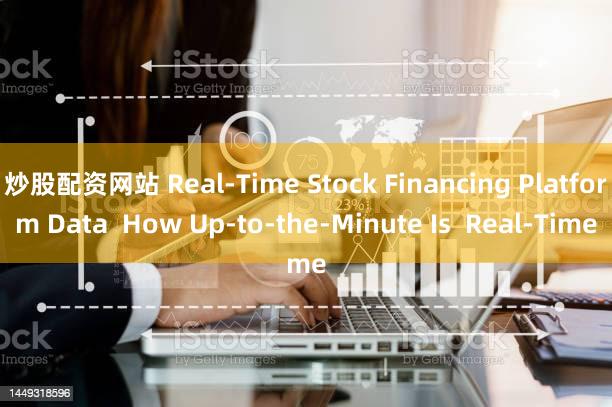
Meta Description: Dive deep into the world of real-time stock financing platforms. Learn about data accuracy, latency, and the crucial factors impacting the timeliness of information impacting your investment decisions. Discover how to choose a platform that truly delivers real-time data.
Is your investment strategy as fast as the market? In today's hyper-connected world, speed is everything. A split-second delay can mean the difference between a profitable trade and a missed opportunity. This is especially true in the dynamic realm of stock trading, where milliseconds matter. But how "real-time" is the real-time data you're relying on from your stock financing platform? This isn't just a technical question; it's a fundamental aspect that directly impacts your financial success. We're not talking about theoretical delays; we're talking about the concrete impact on your bottom line. Imagine placing an order based on seemingly up-to-the-minute information, only to discover that the price has already shifted significantly due to a hidden lag. Frustrating, right? That's why understanding the nuances of real-time data in stock financing platforms is paramount. This isn't just about numbers on a screen; it's about navigating the complexities of the market with confidence, using information you can trust. This in-depth guide will demystify the world of real-time data, equipping you with the knowledge to choose a platform that truly empowers your trading strategy and, ultimately, your financial goals. We'll explore the technicalities, uncover hidden delays, and offer practical advice to ensure you're always one step ahead. Ready to dive in? Let's get started!
The term "real-time" gets thrown around a lot, but its meaning isn't always crystal clear, especially in the context of stock financing. While seemingly straightforward, it encompasses a range of complexities. True real-time data would ideally reflect the exact market price at the very moment you request it. However, in practice, a slight delay, or latency, is almost unavoidable. This latency stems from various factors, including network speed, data transmission, and the platform's processing power. Think of it like this: the stock market is a constantly moving river; real-time data aims to capture a snapshot of that river at a given moment, but getting a perfectly instantaneous picture is challenging.
Several factors influence the accuracy and speed of data delivery:
Latency, that subtle delay, is the silent thief of profits. Even a delay of a few hundred milliseconds can significantly impact trading decisions, particularly in high-frequency trading (HFT). For example, a 200-millisecond delay might seem insignificant, but in a rapidly changing market, that's enough time for the price to move considerably, leading to slippage (the difference between the expected price and the actual execution price). This slippage can erode profits, especially if you're making numerous trades.
Consider this scenario: You see a stock price drop slightly on your platform and decide to buy. However, due to latency, the price shown on your screen is already outdated. By the time your order is executed, the price has already rebounded, resulting in a less favorable purchase price. Ouch! That's a direct consequence of latency.
Therefore, understanding the typical latency of your chosen platform is critical. Reputable platforms will usually disclose their average latency, though this information isn't always readily available.
Selecting the right platform is crucial. Here's what to look for:
Q1: How can I measure the latency of my trading platform?
A1: Precisely measuring latency requires specialized tools and technical expertise. However, you can get a general sense by comparing the data displayed on your platform with live market data from a reputable financial news website. If you consistently notice discrepancies, it suggests latency issues.
Q2: Do all real-time stock financing platforms offer the same level of data accuracy?
A2: Absolutely not. Data accuracy varies significantly depending on the data provider, platform infrastructure, and market conditions. Some platforms are significantly more reliable than others.
Q3: What should I do if I suspect my platform is providing inaccurate data?
A3: Contact your platform's customer support immediately. Report the issue and provide specific examples. Consider switching platforms if the problem persists.
Q4: Is it worth paying more for a platform with lower latency?
A4: For active traders, especially those using HFT strategies, the cost of a lower-latency platform is often justified by the potential increase in profits. For less active investors, the benefits might be less significant.
Q5: Can I reduce latency by upgrading my internet connection?
A5: Yes, a faster and more stable internet connection can definitely help reduce latency. However, it won't eliminate it entirely, as other factors (like platform processing) also contribute.
Q6: What are the legal implications of inaccurate real-time data provided by a platform?
A6: Inaccurate data can lead to substantial financial losses. While legal recourse depends on specific circumstances and jurisdiction, it's crucial to use a reputable platform and document any instances of inaccurate data.
The quest for real-time data in stock financing is a constant pursuit of speed and accuracy. While true instantaneous data is elusive, understanding the nuances of latency, data providers, and platform capabilities is essential for successful trading. By carefully selecting a platform that prioritizes data quality and transparency, and by being mindful of potential delays, you can significantly improve your chances of making informed and profitable investment decisions. Remember, informed decisions lead to better outcomes. So, choose wisely, stay informed, and happy trading!
文章为作者独立观点,不代表财盛证券观点